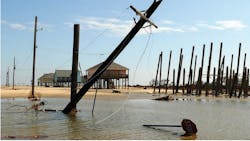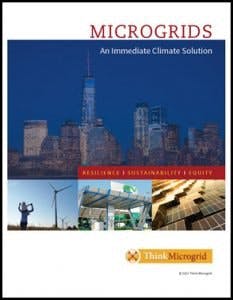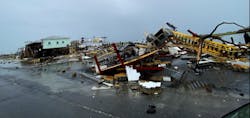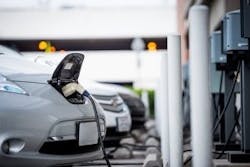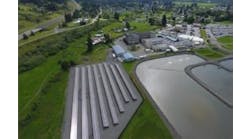In the second article of this special report series brought to you by Microgrid Knowledge and Think Microgrid, we’ll explore why the electric grid is not prepared for the 21st century.
Read the entire vision paper.
Climate disaster is upon us. We are not ready.
Electricity is essential to survival and prosperity in a contemporary world, but the electric grid — the vehicle through which most electricity is delivered — is a clear casualty of climate change. A series of climate disasters has disrupted the electric grid over the last decade, highlighting the vulnerability and brittleness of the system.
High winds cause significant damage to utility infrastructure. The list is long of coastal storms that have led to massive power outages. In 2012, Superstorm Sandy left 8 million people without power, some for weeks. In 2017, Puerto Rico experienced the largest blackout in US history when its entire grid collapsed during Hurricane Maria. Some were without power for a year. During the last decade, we have also seen forced public safety power shutoffs in California and other western states, with utilities preemptively turning off electricity to prevent electrical wires from sparking wildfires. This disruptive practice could continue for as long as a decade, according to a California utility executive. In the Midwest, an August 2020 derecho spawned winds of 140 mph (equivalent to a Category 4 hurricane), creating the most expensive thunderstorm in US history, with an estimated $11.5 billion in damages. The storm knocked out power to nearly 2 million people. Most recently, on Aug. 29, 2021, New Orleans lost all eight of its transmission lines when it was struck by Ida, a Category 4 hurricane. More than 1 million people lost their power.
Windstorms aren’t the only threat to our electric grid. Extreme heat and cold also interrupt the flow of electricity. Extreme heat throughout the West led to rolling blackouts in California in the summer of 2020, and extreme cold crippled Texas’ electrical system in February 2021. In this last example, the situation was so dire that the entire Texas electric grid was moments from collapse — an event that would have knocked out power to most of the state for weeks, if not months, according to the Electric Reliability Council of Texas (ERCOT), the grid operator.
These are just a few examples of the storms and natural disasters that have caused expensive and sometimes deadly power outages in the US over the last decade. The US experienced 1.33 billion outage hours in 2020, up 73% from roughly 770 million in 2019, according to PowerOutage.US, an aggregator of utility blackout data. Grid outages vary from year to year, depending on the weather, but it is reasonable to assume they will continue to trend upward in the future, given that climate disasters are expected to intensify. Presently, grid quality in the US is ranked a lowly 23rd, below countries in Asia, Europe, the Middle East and South America.
Outages are more than an inconvenience. Injury and death can result when heating systems, air conditioning, and medical equipment do not function properly. More than 200 people died, most from hypothermia, during the 2021 Winter Storm Uri power outages in Texas. In 2017, 12 elderly people died in Hollywood, Florida, when a nursing home’s air conditioning failed following a power outage caused by Hurricane Irma.
Power disruptions also lead to economic hardship, causing lost business sales, product spoilage, missed sales opportunities, manufacturing and shipping delays, and loss of work hours for employees. A 2021 survey by S&C Electric and Frost & Sullivan found that 80% of commercial and industrial companies with average revenues of $75 million per year experience outages every month, resulting in an annual loss of $1.2 million per company. And these outages do not need to be lengthy to be expensive. More than half of companies surveyed said it was very important that power be restored within one minute.
Electrification is upon us. We are not ready.
All of this comes as the need for power grows. The United States is working toward the electrification of the transportation sector, and, to a lesser degree, the electrification of buildings and industrial processes. These changes, part of the country’s effort to decarbonize, will double the need for generation capacity by 2050, according to the National Renewable Energy Laboratory. The Boston Consulting Group said that to facilitate growth of electric vehicles (EVs), utilities will need to invest between $1,700 and $5,800 in grid upgrades per EV through 2030. This could increase utility rates as much as 12%.
Such high cost is due, in part, to the need to rebuild the electric grid itself for the emerging era. EV charging requires a change in the pattern of energy use; for example, the US will need charging stations along remote roads that do not have adequate power lines because they required little power in the past. Expanding those lines can cost as much as $1.5 million per mile. Placing lines underground can increase the cost four to 14 times!
Demand will grow for electrical capacity in dense urban areas to serve fleets of delivery trucks and corporate vehicles. Unfortunately, these areas have little real estate available for new power plants, substations, or transmission and distribution lines. And, depending on the charging patterns of EV owners, the timing and location of demand peaks will likely change, redefining where energy infrastructure is needed.
Digitization, flexibility and decentralization transform energy
How can we ready the grid for 21st century electrification without the construction of expensive new large-scale energy infrastructure?
We can reduce outages and decrease these new infrastructure costs through refined energy management made possible through intelligent software and distributed energy resources (DERs) like microgrids. The combination adds both flexibility and control over energy flows locally and across the grid, facilitated by automated market signals. This allows both consumers and producers to take advantage of the fact that emissions and energy prices are heavily influenced by the timing and location of energy use.
Typically, when demand is high, energy prices rise. Emissions may also rise during periods of demand if grid operators are forced to employ their highest polluting resources to satisfy the immediate need for power. Distributed energy resources, such as microgrids, solar, energy storage and generators, provide an alternative. Because they are decentralized — found alongside businesses, homes and buildings dispersed throughout the grid — they can be customized to serve the grid in locations where large power plants cannot. These resources are also quick to respond as conditions change moment by moment on the grid.
A microgrid future
Microgrids and DERs give rise to customers who are more engaged. These customers control their own energy, both consuming and producing, and sometimes earn revenue and aid the larger grid in the process. When considered properly in planning grid upgrades, these software-based, distributed energy systems can help avoid costly construction of poles, wires and power plants. This is one reason why more brick and mortar for the electric grid is not the full answer in a digitized age. In fact, at times, it may be wasteful.
In the coming weeks, this special report series will explore the following topics:
- Why the Grid is Not Enough
- Microgrids for a 21st Century Grid.
- How to Capture the Full Benefits of Microgrids in Climate Change Strategies and Infrastructure Plans.
Read the full vision paper, courtesy of Think Microgrid, to learn more. If you feel that microgrids need a unified voice in regulatory and policy discussion, please join Think Microgrid. Learn more about becoming a member of Think Microgrid.
